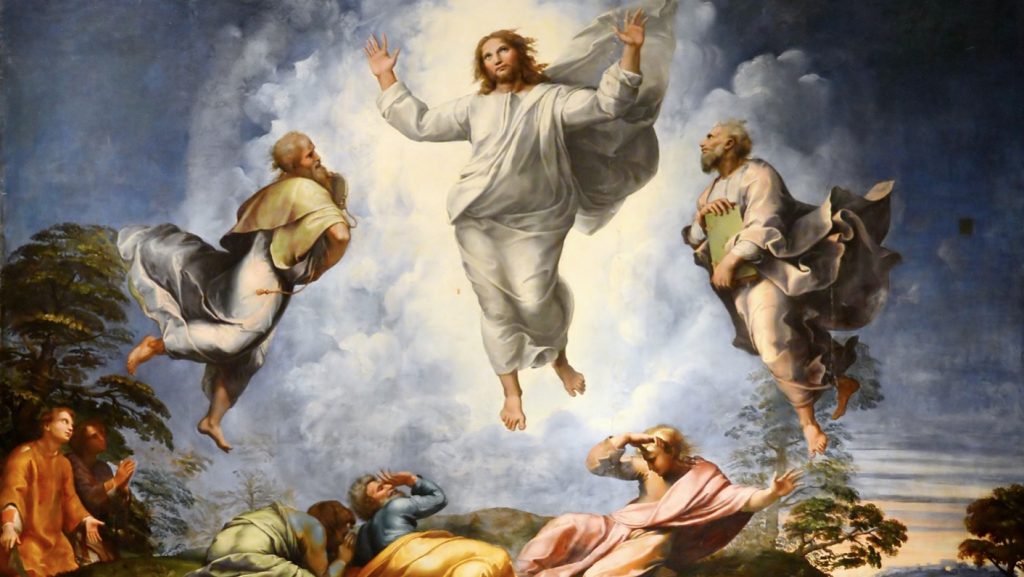The Biblical character of Jesus began as a human Jewish preacher, and gradually evolved into part of a newly invented Christian god.
 |
| Image: from Raphael’s Transfiguration |
Also, his special relationship with the main Christian god gradually started earlier and earlier as time went on.
To better understand the biblical Jesus, read the books of the New Testament in the sequence in which they were written, instead of the sequence in which they appear in the Bible.
Paul wrote his letters first, about 48-62 CE and he wrote almost nothing about the earthly life of Jesus.
The Book of Revelation, with its violent, avenging Jesus, was written in stages between about 60-95 CE.
The Gospel called Mark was written about 65-70 CE, and it has no virgin birth and no detail of the resurrection.
At this stage, the Jesus character was still an apocalyptic preacher warning people that the world was coming to an end within the lifetime of those listening to him.
The virgin birth and resurrection stories first appear in the Gospels called Matthew and Luke, which were written about 80-85 CE, as was the Book of Acts, some of which contradicts what Paul earlier wrote about himself.
The Gospel called John was written about 90-95 CE and is the first book that suggests Jesus was actually a god, as distinct from a human being who had a special relationship with a god.
By now, people knew the world had not ended within the lifetime of those listening to Jesus, so the message evolved into a more metaphysical long-term one.
Also, the special relationship that the Jesus character has with the main god keeps getting pushed back earlier in time.
It started from his resurrection in the letters of Paul, went back to his baptism in the Gospel called Mark, then further back to his conception in the Gospels called Matthew and Luke, and finally back to the start of time in the Gospel called John.
For a comprehensive analysis of these and similar themes, read the work of Bart Ehrman and other academic textual critics of the New Testament.
Such fantastic and wildly inconsistent stories may have seemed convincing in more primitive times, written as they were as standalone stories in different places for different audiences, many of whom believed the world was coming to an end in their lifetimes.
To better understand the biblical Jesus, read the books of the New Testament in the sequence in which they were written, instead of the sequence in which they appear in the Bible.
Paul wrote his letters first, about 48-62 CE and he wrote almost nothing about the earthly life of Jesus.
The Book of Revelation, with its violent, avenging Jesus, was written in stages between about 60-95 CE.
The Gospel called Mark was written about 65-70 CE, and it has no virgin birth and no detail of the resurrection.
At this stage, the Jesus character was still an apocalyptic preacher warning people that the world was coming to an end within the lifetime of those listening to him.
The virgin birth and resurrection stories first appear in the Gospels called Matthew and Luke, which were written about 80-85 CE, as was the Book of Acts, some of which contradicts what Paul earlier wrote about himself.
The Gospel called John was written about 90-95 CE and is the first book that suggests Jesus was actually a god, as distinct from a human being who had a special relationship with a god.
By now, people knew the world had not ended within the lifetime of those listening to Jesus, so the message evolved into a more metaphysical long-term one.
Also, the special relationship that the Jesus character has with the main god keeps getting pushed back earlier in time.
It started from his resurrection in the letters of Paul, went back to his baptism in the Gospel called Mark, then further back to his conception in the Gospels called Matthew and Luke, and finally back to the start of time in the Gospel called John.
For a comprehensive analysis of these and similar themes, read the work of Bart Ehrman and other academic textual critics of the New Testament.
Such fantastic and wildly inconsistent stories may have seemed convincing in more primitive times, written as they were as standalone stories in different places for different audiences, many of whom believed the world was coming to an end in their lifetimes.







No comments